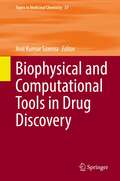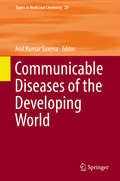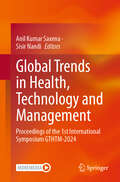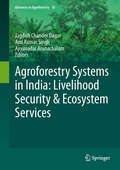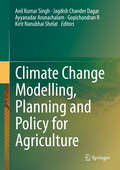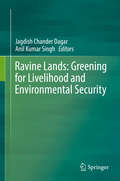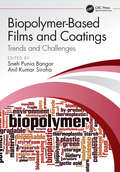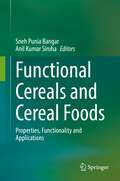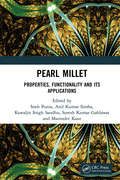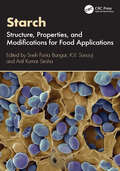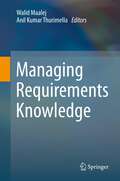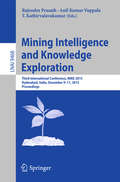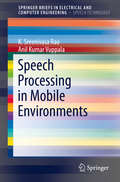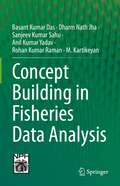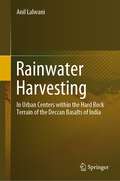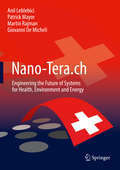- Table View
- List View
Green Diesel: An Alternative to Biodiesel and Petrodiesel (Advances in Sustainability Science and Technology)
by Mohammad Aslam Shrikant Shivaji Maktedar Anil Kumar SarmaThis book covers the entire spectrum of green diesel and their applications in existing CI engines. This book discusses how a green diesel is a better fuel than biodiesel and petrodiesel and more suitable fuels for sustainable future development. The book begins with a concise overview of the fundamentals of the green diesel properties, preparation, and characterization of green diesel using hydroprocessing technology. The book covers recent developments in the domain of green diesel derived particularly from the second-/third-generation feedstocks. Various topics covered in this book include the catalysts involved in the processing of green diesel, characterization of the products as per ASTM/EN protocols. In addition, the book also illustrates characteristic features of green diesel and how it is different from biodiesel and petrodiesel. Other chapters cover performance and emission characteristics of green diesel in CI engines and techno-economic analysis. Moreover, the current status of green diesel industries is also incorporated. This book is of particular interest to graduate students and academic or industrial researchers/professionals working in the area of green diesel/green energy, bioenergy and mechanical, automobile, and chemical engineering. This book makes a forceful foundation for the establishment of green diesel refineries/biorefineries for a sustainable, cleaner, and greener future.
Biophysical and Computational Tools in Drug Discovery (Topics in Medicinal Chemistry #37)
by Anil Kumar SaxenaThis book reviews recent physicochemical and biophysical techniques applied in drug discovery research, and it outlines the latest advances in computational drug design. Divided into 10 chapters, the book discusses about the role of structural biology in drug discovery, and offers useful application cases of several biophysical and computational methods, including time-resolved fluorometry (TRF) with Förster resonance energy transfer (FRET), X-Ray crystallography, nuclear magnetic resonance spectroscopy, mass spectroscopy, generative machine learning for inverse molecular design, quantum mechanics/molecular mechanics (QM/MM,ONIOM) and quantum molecular dynamics (QMT) methods. Particular attention is given to computational search techniques applied to peptide vaccines using novel mathematical descriptors and structure and ligand-based virtual screening techniques in drug discovery research. Given its scope, the book is a valuable resource for students, researchers and professionals from pharmaceutical industry interested in drug design and discovery.
Communicable Diseases of the Developing World (Topics In Medicinal Chemistry Ser. #29)
by Anil Kumar SaxenaThis book reviews the current strategies and challenges for the treatment of bacterial, fungal, parasitic and viral infectious diseases in developing countries. Contributing authors present expert analysis on the transmission, epidemiology, bacteriology, pathogenesis and treatment of Neglected Tropical Bacterial Diseases such as Leprosy, Buruli ulcer, and Trachoma. Particular attention is also given to current antifungal agents, their spectrum of activity, mode of action, limitations, and current challenges in antifungal therapy. The authors explore the medicinal chemistry efforts that gave rise to currently launched drugs and new anti-HIV agents, and they also highlight the latest vaccine and drug developments in the clinical management of the Ebola Virus Disease, ignited by the 2014-2016 outbreak. This work has an interdisciplinary appeal and will engage scholars and professionals in the burden of communicable diseases.
Global Trends in Health, Technology and Management: Proceedings of the 1st International Symposium GTHTM-2024
by Anil Kumar Saxena Sisir NandiThis book presents the proceedings of the 1st International Symposium on Global Trends in Health, Technology and Management (GTHTM-2024), held on March 15-17, 2024, in Dehradun, India. It reports on recent advances in the interdisciplinary fields of health, technology, and management covering a broad spectrum of topics like drug discovery and development including diseases like cancer, tropical and lifestyle diseases, agroecology, artificial intelligence, and machine learning. The symposium is jointly organised by the Global Health Techno Management Forum and the Global Institute of Pharmaceutical Education and Research, Kashipur, India, together with the Veer Madho Singh Bhandari Uttarakhand Technical University, Dehradun, India. It builds on the success of previous conferences such as the International Symposium on Drug Design and Development Research (DDDR-2021), International Symposium on Current Trends in Pharmaceutical and Medical Sciences (CTPMS-2020), International seminar on Global Trends in Health and Environment (2016), International Seminar on Pharmaceutical Education and Research (ISPER-2010), and the 9th International Symposium on Computational Methods in Toxicology and Pharmacology Integrating Internet Resources (CMTPI-2017). Offering a timely snapshot of cutting-edge, multidisciplinary research and developments in drug design and health sciences, these proceedings facilitate the transfer of these findings to industry and offer a unique perspective on One Health sustainability. As such, the book will appeal not only to students and researchers but also to professionals interested in these fields.
Acaricides Resistance in Ticks: A Global Problem
by Sachin Kumar Anil Kumar Sharma Raquel Cossío-Bayúgar Estefan Miranda-Miranda Ashok Kumar ChaubeyThis book discusses the significance of the chemical acaricides resistance in ticks as a global problem. Resistance is the ability of a tick population to survive and reproduce in the presence of a pesticide that would otherwise be lethal. This resistance threatens the efficacy of a range of acaricides used to control tick populations and consequently, has a negative impact on the effectiveness of various pest management strategies. This resistance is caused by the selection of resistant tick genotypes and enhanced metabolic detoxification. To address this problem the book explores an integrated approach that is needed to identify and manage tick populations that are resistant to acaricides, as well as identify and develop novel acaricides that are effective against resistant tick species populations. It describes the complex issues associated with this phenomenon using cutting edge advancement in Bioinformatics and Bioinformation Discovery. The chapters provide current information pertaining to the types of protein-protein complexes (homodimers, heterodimers, multimer complexes) in context with various specific and sensitive biological functions. The significance of such complex formation in human biology in the light of molecular evolution is also highlighted using several examples. The book serves as a valuable resource for students, academicians and researchers studying about tick resistance.
Advances in Environmental Biotechnology
by Raman Kumar Anil Kumar Sharma Sarabjeet Singh AhluwaliaThe book aims to provide a comprehensive view of advanced environmental approaches for wastewater treatment, heavy metal removal, pesticide degradation, dye removal, waste management, microbial transformation of environmental contaminants etc. With advancements in the area of Environmental Biotechnology, researchers are looking for the new opportunities to improve quality standards and environment. Recent technologies have given impetus to the possibility of using renewable raw materials as a potential source of energy. Cost intensive and eco-friendly technology for producing high quality products and efficient ways to recycle waste to minimize environmental pollution is the need of hour. The use of bioremediation technologies through microbial communities is another viable option to remediate environmental pollutants, such as heavy metals, pesticides and dyes etc. Since physico-chemical technologies employed in the past have many potential drawbacks including higher cost, and lower sustainability. So there is need of efficient biotechnological alternatives to overcome increasing environmental pollution. Hence, there is a need for environmental friendly technologies that can reduce the pollutants causing adverse hazards on humans and surrounding environment.
Millet Rhizosphere (Rhizosphere Biology)
by Anil Kumar Sharma Ramesh Namdeo Pudake Maya Kumari Deepak Rameshwar SapkalThis edited volume is the first book that explicitly explains the link between the extraordinarily small-scale microbial processes and the growth and yield attributes of millet crops. This book includes chapters emphasizing on the effects of rhizosphere biology on long-term millet crop management. Millets are a collection of small-grained cereal grasses that are grown for human carbohydrate needs. They are among the oldest crops, mainly divided into two groups: major and small millets based on seed size. Major millets are composed of sorghum (Sorghum bicolor) and pearl millet (Pennisetum glaucum); while small millets are composed of six species that includes finger millet (Eleusine coracana (L.)), little millet (Panicum sumatrense), kodo millet (Paspalum scrobiculatum (L.)), foxtail millet (Setaria italica (L.)), barnyard millet (Echinochloa frumentacea (L.)), and proso millet (Panicum miliaceum (L.). These crops are earlier considered as orphan crops, but recently due to their nutritional values it is gaining the importance. Various reports are published based on role of rhizosphere on growth and health of these crops. The rhizosphere being a dynamic interface among the plant roots and soil microbes provides a number of advantages to the millets too. The soil properties in rhizospheric region are also different as compared to the bulk soil. This book discovers the functional attributes of rhizosphere in promoting the healthy growth of millet crop and achieving higher yield during the changing climatic condition. This book is of interest to university teachers, scientists working in the millets, and policymakers in agricultural departments. Also, the book serves as additional reading material for undergraduate and graduate students of agriculture, biotechnology, microbiology, genetics, and soil science.
Agroforestry Systems in India: Livelihood Security And Ecosystem Services (Advances in Agroforestry #10)
by Jagdish Chander Dagar Anil Kumar Singh Ayyanadar ArunachalamAgroforestry, the word coined in early seventies, has made its place in all the developed and the developing countries of the world and is now recognized as an important approach to ensuring food security and rebuilding resilient rural environments. India has been an all-time leader in agroforestry. The South and Southeast Asia region comprising India is often described as the cradle of agroforestry. Almost all forms of agroforestry systems exist across India in ecozones ranging from humid tropical lowlands to high-altitude and temperate biomes, and perhumid rainforest zones to parched drylands. The country ranks foremost among the community of nations not only in terms of this enormous diversity and long tradition of the practice of agroforestry, but also in fostering scientific developments in the subject. Agroforestry applies to private agricultural and forest lands and communities that also include highly erodible, flood-prone, economically marginal and environmentally sensitive lands. The typical situation is agricultural, where trees are added to create desired benefits. Agroforestry allows for the diversification of farm activities and makes better use of environmental resources. Owing to an increase in the population of human and cattle, there is increasing demand of food as well as fodder, particularly in developing countries like India. So far, there is no policy that deals with specifics in agroforestry in India. But, the Indian Council of Agricultural Research has been discussing on the scope of having a National Agroforestry Policy in appropriate platforms. However, evolving a policy requires good and reliable datasets from different corners of the country on the subject matter. This synthesis volume containing 13 chapters is an attempt to collate available information in a classified manner into different system ecologies, problems and solutions, and converging them into a policy support.
Allele Mining for Genomic Designing of Fruit Crops (Nextgen Agriculture)
by Chittaranjan Kole Anil Kumar Singh Kenta ShirasawaThis book deliberates on the concept, strategies, tools, and techniques of allele mining in fruit crops and its application potential in genome elucidation and improvement including studying allele evolution, discovery of superior alleles, discerning new haplotypes, assessment of intra- and interspecific similarity, and also studies of gene expression and gene prediction. Available gene pools in global germplasm collections specifically consisting of wild allied species and local landraces for almost all major crops have facilitated allele mining. Advanced genomic techniques have been developed including PCR-based allele priming and Eco-TILLING-based allele mining that are being widely used now for mining superior alleles. Allele discovery has become more relevant now for employing molecular breeding to develop designed crop varieties matching with consumer needs and also with genome plasticity to adapt the climate change scenarios. All these concepts and strategies along with precise success stories are presented over the chapters dedicated to the major fruit crops.The features of this book are as follows: The first book on the novel strategy of allele mining in fruit crops for precise breeding Presents genomic strategies of mining superior alleles underlying agronomic traits from genomic resources Depicts case studies of PCR-based allele priming and Eco-TILLING-based allele mining Elaborates on gene discovery and gene prediction in major fruit crops This book will be useful to students and faculties in various plant science disciplines including genetics, genomics, molecular breeding, agronomy, and bioinformatics; scientists in seed industries; and also policy makers and funding agencies interested in crop improvement.
Climate Change Modelling, Planning and Policy for Agriculture
by Jagdish Chander Dagar Anil Kumar Singh Ayyanadar Arunachalam Gopichandran R Kirit Nanubhai ShelatIt is well known that the impacts of climate change are tangible and hence there can be no debate about the need for appropriate adaptation measures, on a priority basis. However, it is equally important to recognize the fact that adaptation measures actually represent a dynamic synthesis of interventions pertaining to multiple systems. These are particularly of water, soil characteristics, genotypic and phenotypic variations and their expressions, age-correlated biochemical changes aligned with planting schedules and favorable weather/climate conditions. Nutrients, occurrence and distribution of associated vegetation including crop mixes also influence productivity. The overarching aspect of farming practice wields significant influence on the outcome and hence it is important to be clear about the particular focus of the investigations being carried out and reported in a suitable manner. It is essential to recognize that scientific research in agriculture in India has always produced valuable results of direct relevance to her people. Importantly, preparedness to tackle disasters due to inclement weather system has prominently featured on the agenda. The recent focus on climate change and impacts has provided the necessary impetus to reorganize the framework of investigation to capture the specifics of such impacts. In this context, the importance of micro climate variations too viz-a-viz the larger scales of impacts cannot be overemphasized. It will be useful to also help characterize natural variations versus artificially induced variations, helping us understand the complexities of individual and synergistic impacts too. Obviously, the limits and limitations of models could determine the spread and depth of the outcomes of investigations. Empirical evidences to reinforce assumptions have to also be documented with utmost care; guided by an understanding of the limits of tolerance, limiting factors, and the precautionary principle especially in the public policy interface. The present volume therefore, showcases these strands with the fond hope that they will stimulate further thinking and enable appropriate action.
Ravine Lands: Greening for Livelihood and Environmental Security
by Jagdish Chander Dagar Anil Kumar SinghThis book, the only one of its kind on ravine lands, reflects the significant advances made over the past two decades in our understanding of gully erosion, its controlling factors, and various aspects of gully erosion. It also addresses central research gaps and unanswered questions, which include historical studies on gully erosion to better understand the different stages of their formation; appropriate measuring techniques for monitoring or assessing the geological and hydrological parameters and processes involved in gully development; interaction of hydrological and other soil degradation processes; ecology and biodiversity of fragile ravines; impact of climate and environmental changes on soil erosion processes; development of effective and reliable gully erosion models; effective gully prevention and control measures; watershed-based management options; and ravine rehabilitation policies. The present book is a highly timely publication and deals with various aspects of ravine ecology and rehabilitation of degraded lands, particularly with the aid of biological approaches. As such, it offers a valuable guide for all scientists working in the fields of soil conservation / rehabilitation and agroforestry, students, environmentalists, educationists, and policymakers. More importantly, it focuses on the rehabilitation of one of the world’s most degraded and fragile ecosystems, ensuring the livelihoods of resource-poor farmers and landless families living in harsh ecologies that are more vulnerable to climate change.
Biopolymer-Based Films and Coatings: Trends and Challenges
by Anil Kumar Siroha Sneh Punia BangarWith the growing concern for the environment and the rising price of crude oil, there is increasing demand for non-petroleum-based polymers from renewable resources. Biopolymer films have been regarded as potential replacements for synthetic films in food packaging due to a strong marketing trend toward environmentally friendly materials. Biopolymer-based films and coatings display good barrier properties, flexibility, transparency, economic profitability, and environmental compatibility. Therefore, they have successfully been used for packaging various food products. Biopolymer-Based Films and Coatings: Trends and Challenges elaborates on the recent methods and ingredients for making biodegradable films and coatings, as well as the current requirements for food security and environmental issues. This book also explores films and coatings prepared with essential oils, antimicrobial substances, and bioactive components that make up this active packaging. Films and coating chapters are based on biopolymers used to prepare films and coatings, that is, carbohydrates, lipids, proteins, and so on. This book provides a platform for researchers and industrialists on the basic and advanced concepts of films and coatings. Key Features Provides a comprehensive analysis of recent findings on biopolymers (carbohydrate-, protein-, and lipid-) based films and coatings Contains a wealth of new information on the properties, functionality, and applications of films and coatings Presents possible active and functional components and ingredients for developing films and coatings. Guides start-up researchers on where to start the latest research work in packaging It has been estimated that the global production of bioplastics is set to hike from ~2.11 in 2020 to ~2.87 million tonnes in 2025. Further, the demand for fresh, ready-to-eat, or semi-finished foods is increasing, and the need to maintain food safety and quality further exacerbates the challenges in the supply chain, especially with the globalization of food trade and the use of centralized processing facilities for food distribution. It is an urgent requirement to increase shelf life and reduce food product loss. Considering the great market demand for biodegradable material-based packaging systems, this book comes at an opportune time to enable researchers and food scientists to develop suitable solutions considering the sustainability and economic feasibility of the process.
Functional Cereals and Cereal Foods: Properties, Functionality and Applications
by Anil Kumar Siroha Sneh Punia BangarIn recent years, consumers are concentrating more on the health benefits of food in order to preserve a healthy lifestyle and therefore becoming more aware of the relationship between diet and disease. This has resulted in a gradual shift from animal-derived to plant-based meals. Functional foods have turned into one of the rapidly expanding areas of the food industry due to the increasing awareness of consumers working to prevent lethal diseases like cancer, diabetes mellitus and cardiovascular disease. Functional foods are seen as the food or food components that manifest efficiency in protecting from diseases and attaining a healthier lifestyle by administering additional benefits on human physiology and metabolic functions apart from basic nutritional requirements of the body. Cereals hold a prominent place in this new market. Cereals and cereal foods are important energy sources and many phytochemicals such as dietary fiber, resistant starch, vitamins, minerals, lignans, phytic acid and phenolic compounds that provide a variety of health benefits. Eating functional cereal foods is an easy method to increase nutrients associated with whole grains without changing eating habits. Functional Cereals and Cereal Foods: Properties, Functionality and Applications comprehensively covers the Chemistry and nutritional composition of functional cereals components, their functionality and therapeutic significance, current innovations and functional approaches in improving attributes and biofortification and quality improvement of cereal products. The different types of functional cereals and their unlimited opportunities for the production of functional foods are covered in full, including gluten-free products and all the newest cereal processing technologies. For researchers in search of a fully up-to-date look at functional cereal foods and technologies and their important place on the current market, this text provides a timely and comprehensive overview.
Millets: Properties, Processing, and Health Benefits
by Sneh Punia Anil Kumar Siroha Sukhvinder Singh Purewal Kawaljit Singh SandhuMillets are low cost cereal grains and widely used in the food industry and animal husbandry as an important source of food and feed. As a rich source of starch, protein, minerals, vitamins, and specific bioactive compounds that contain beneficial antioxidant properties, they have gained considerable attention as a botanical dietary supplement and various functional foods. Millets: Properties, Processing, and Health Benefits explores millet production, chemistry and nutritional aspects, processing technologies, product formulations, and more. Understanding the properties of millets provides a basis for better utilizing millet crops, in addition to further development of millets as an important industrial crop. Key Features: Provides millet taxonomy, history, nutritional aspects, and health benefits Discusses the physical and functional properties of millets Explores various millet-based products Deals with starch composition, structure, properties, and applications Touches on postharvest management of millets This book combines information on the composition, functional properties and processing along with information on the health properties of millets. With its unique presentation on millets flour and starch, it will be suitable for those wanting to use millets in various food products, including food technologists, nutritionists, research scientists, and agriculture professionals.
Pearl Millet: Properties, Functionality and its Applications
by Suresh Kumar Gahlawat Sneh Punia Anil Kumar Siroha Kawaljit Singh Sandhu Maninder KaurPearl millet is mainly used for animal and poultry feed. It is the principal source of energy, protein, vitamins, minerals and contains many phenolic compounds, which are a good source of natural antioxidants. Pearl millet is a rich source of bioactive compounds and contains phytates and polyphenols. Owing to high nutritional and phytochemical properties, it has gained considerable attention as a botanical dietary supplement in many functional foods. Pearl Millet: Properties, Functionality and Its Applications provides comprehensive knowledge on nutritional and non-nutritional aspects of pearl millet. It covers recent research on pearl millet and provides information to improve the property and shelf life of flour, as well as the starch, and their uses in various food products. Features: Reviews structure, functional and antioxidant properties in pearl millet flour Deals with the latest developments in modification of native starch Provides information in enhancing shelf life and its utilization in phytochemical-rich product development Covers updated information for grain science professionals and food technologists
Starch: Structure, Properties, and Modifications for Food Applications
by Anil Kumar Siroha Sneh Punia Bangar K. V. SunoojStarch is the principal source of stored energy in plants, and its chemical composition varies depending on the botanical source of the starch. Starch plays a significant role in determining the structural characteristics of finished food products. "Starch: Structure, Properties, and Modifications for Food Applications" explores the comprehensive overview of the basic structure and properties of starch as well as the modification of starch with physical, chemical, and enzymatic methods. Each chapter presents an in-depth review of a specific research area updated with current research. Chapters of this book provide comprehensive information regarding starch modification, which will help to design new, healthy starch-based food products.Key Features: This book will cover the functional characteristics of conventional and non-conventional starches It covers the different methods of starch modification, including physical, chemical, and enzymatic methods The latest information on the properties of modified starch is from different sources This book will explore the current and emerging application trends of modified starches With contributions from esteemed researchers worldwide, this book serves as an invaluable resource for students, food technologists, researchers, and industry professionals seeking to deepen their understanding of modified starches and their diverse applications. We hope that the insights offered within these pages inspire new avenues of research and innovation, ultimately contributing to continued advancement in food technology.
Ship-Shaped Offshore Installations
by Jeom Kee Paik Anil Kumar ThayamballiShip-shaped offshore units are some of the more economical systems for the development of offshore oil and gas, and are often preferred in marginal fields. These systems are especially attractive to develop oil and gas fields in deep and ultra-deep water areas and remote locations away from existing pipeline infrastructures. Recently, the ship-shaped offshore units have been applied to near shore oil and gas terminals. This 2007 text is an ideal reference on the technologies for design, building and operation of ship-shaped offshore units, within inevitable space requirements. The book includes a range of topics, from the initial contracting strategy to decommissioning and the removal of the units concerned. Coverage includes both fundamental theory and principles of the individual technologies. This book will be useful to students who will be approaching the subject for the first time as well as designers working on the engineering for ship-shaped offshore installations.
Managing Requirements Knowledge
by Anil Kumar Thurimella Walid MaalejRequirements engineering is one of the most complex and at the same time most crucial aspects of software engineering. It typically involves different stakeholders with different backgrounds. Constant changes in both the problem and the solution domain make the work of the stakeholders extremely dynamic. New problems are discovered, additional information is needed, alternative solutions are proposed, several options are evaluated, and new hands-on experience is gained on a daily basis. The knowledge needed to define and implement requirements is immense, often interdisciplinary and constantly expanding. It typically includes engineering, management and collaboration information, as well as psychological aspects and best practices. This book discusses systematic means for managing requirements knowledge and its owners as valuable assets. It focuses on potentials and benefits of "lightweight," modern knowledge technologies such as semantic Wikis, machine learning, and recommender systems applied to requirements engineering. The 17 chapters are authored by some of the most renowned researchers in the field, distilling the discussions held over the last five years at the MARK workshop series. They present novel ideas, emerging methodologies, frameworks, tools and key industrial experience in capturing, representing, sharing, and reusing knowledge in requirements engineering. While the book primarily addresses researchers and graduate students, practitioners will also benefit from the reports and approaches presented in this comprehensive work.
Reason, Religion and Modernity: Gadamer-Habermas Debate (SpringerBriefs in Philosophy)
by Anil Kumar VaddirajuThis book deals with the question of understanding religion and its relationship with politics in the context of developing countries. It reviews specific theories, such as modernisation theory, marxism, liberalism, hermeneutics and critical approach to explain questions related to religion and religious traditions. The book focuses on the recent attempts to theorise religion by Jurgen Habermas. It argues modernisation and orthodox Marxian theory are inadequate in understanding the recent spurt of religious phenomenon in politics. It discusses Hans-Georg Gadamer’s view to show a way forward regarding dialectical hermeneutics in facilitating a dialogue between different traditions and religions. The book is of interest to students, scholars, practitioners of development, and all those who concern themselves with the questions of religion, tradition, modernity and secular well-being in developing countries such as India and beyond.
Urban Governance and Local Democracy in South India
by Anil Kumar VaddirajuThis book examines the issues of urban governance and local democracy in South India. It is the first comprehensive volume that offers comparative frameworks on urban governance across all states in the region: Karnataka, Andhra Pradesh, Telangana, Tamil Nadu and Kerala. The book focuses on governance in small district-level cities and raises crucial questions such as the nature of urban planning, major outstanding issues for urban local governance, conditions of civic amenities such as drinking water and sanitation and problems of social capital in making urban governance work in these states. It emphasizes on both efficient urban governance and effective local democracy to meet the challenges of fast-paced urbanization in these states while presenting policy lessons from their urbanization processes. Rich in empirical data, this book will be useful to scholars and researchers of political studies, public administration, governance, public policy, development studies and urban studies, as well as practitioners and non-governmental organizations.
Mining Intelligence and Knowledge Exploration
by Anil Kumar Vuppala Rajendra Prasath T. KathirvalavakumarThis book constitutes the refereed proceedings of theThird International Conference on Mining Intelligence and KnowledgeExploration, MIKE 2015, held in Hyderabad, India, in December 2015. The 48 full papers and 8 short papers presented togetherwith 4 doctoral consortium papers were carefully reviewed and selected from 185submissions. The papers cover a wide range of topics including informationretrieval, machine learning, pattern recognition, knowledge discovery,classification, clustering, image processing, network security, speechprocessing, natural language processing, language, cognition and computation,fuzzy sets, and business intelligence.
Speech Processing in Mobile Environments
by K. Sreenivasa Rao Anil Kumar VuppalaThis book focuses on speech processing in the presence of low-bit rate coding and varying background environments. The methods presented in the book exploit the speech events which are robust in noisy environments. Accurate estimation of these crucial events will be useful for carrying out various speech tasks such as speech recognition, speaker recognition and speech rate modification in mobile environments. The authors provide insights into designing and developing robust methods to process the speech in mobile environments. Covering temporal and spectral enhancement methods to minimize the effect of noise and examining methods and models on speech and speaker recognition applications in mobile environments.
Concept Building in Fisheries Data Analysis
by Basant Kumar Das Dharm Nath Jha Sanjeev Kumar Sahu Anil Kumar Yadav Rohan Kumar Raman M. KartikeyanThis authored book is primarily for the readers who are in search of how to use basic concepts of statistics in the field of fishery science. It has been written for the new comers coming in the fishery sector including university students, teachers and research scholars. It enriches the reader’s knowledge of data analysis step by step starting from data collection to its analysis and interpretation along with practical application with real example. It supports readers for enhancing theoretical and practical concept of application of fundamental statistics in fishery domain. Reader may also learn how to analyses data using different statistical software. Each chapter starts with an introduction of the topic followed by statistical concept with example and ends with chapter based question for comprehension purpose. This book is of interest to teachers, researchers, scientists, capacity builders in fishery sciences. Also the book serves as additional reading material for undergraduate and graduate students of fisheries and aquatic sciences.
Rainwater Harvesting: In Urban Centers within the Hard Rock Terrain of the Deccan Basalts of India
by Anil LalwaniOur dependency on groundwater resources and overuse thereof has led to a decline in water table so that in the last couple of decades the focus has shifted back to the traditional practices of rainwater harvesting, and ways and means have been sought to promote Rainwater harvesting in Urban areas to recharge the stressed groundwater systems. This book discusses in brief the classifications of Rainwater harvesting, and the various rainwater harvesting systems that are currently applied. The most important aspect for achieving any groundwater recharge is the availability of source water, this can be evaluated by analyzing the monsoon rainfall pattern, its frequency, number of rainy days, and maximum rainfall in a day and its variation in space and time. The Deccan basalts are one of the most enigmatic rocks in India and pose a very difficult task when it comes to ground water exploration and groundwater recharge, especially in the urban areas where due to constraint of space one needs to resort to borewells for recharge purpose. It is important for any such undertaking to understand the applicability and sustainability aspects of Rainwater harvesting as it is being practiced. This book tries to differentiate the Basaltic Aquifers from the other hard-rock Aquifers, and highlights the difficulties in trying to implement rainwater harvesting by groundwater recharge with the basaltic terrain. It also deals with the issue of long term sustainability of roof top Rainwater to meet the growing demands of fresh water. It also highlights some of the shortcomings in the methodologies used and the requirements for being considered in the various categories of green building rating agencies. It furthermore clarifies the possibility and limitations of dependence of roof top harvesting in addressing the question of water shortages, which is of common occurrence within most urban centres of India. It also helps in clarifying major misconceptions that are currently prevailing regarding Roof top Rainwater harvesting especially within the low capacity aquifers within the hard rock terrain of the Deccan basalts.
Nano-Tera.ch: Engineering the Future of Systems for Health, Environment and Energy
by Anil Leblebici Patrick Mayor Martin Rajman Giovanni De MicheliThis book presents the overall vision and research outcomes of Nano-Tera.ch, which is a landmark Swiss federal program to advance engineering system and device technologies with applications to Health and the Environment, including smart Energy generation and consumption. The authors discuss this unprecedented nation-wide program, with a lifetime of almost 10 years and a public funding of more than 120 MCHF, which helped to position Switzerland at the forefront of the research on multi-scale engineering of complex systems and networks, and strongly impacted the Swiss landscape in Engineering Sciences.

